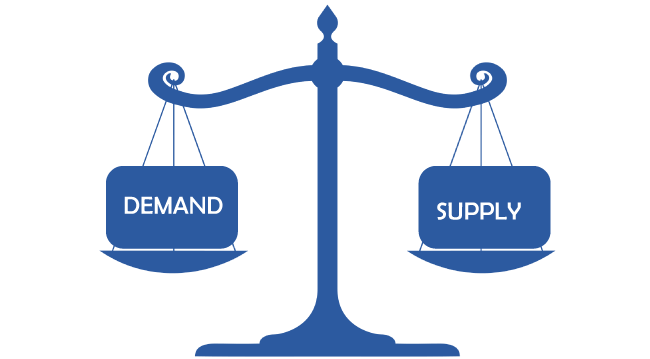4 Factors That Shape Market TrendsTrends give traders and investors the opportunity to make money. Profits and losses are determined by how prices move from one to another, whether they follow this on a short-term or long-term level, in a market that is usually trending, or in one that is rangebound. There are 4 key factors that have an impact on both long-term trends and short-term volatility. These factors include the government, international transactions, speculation and expectation, and supply and demand. 
The way these main factors shape long-term trends might be understood to help predict how future trends can develop. The 4 main factors are described as follows: GovernmentThe influence of government over free markets is considerable. The monetary and fiscal policies implemented by governments and their central banks have a significant impact on the financial sector. They can effectively slow or make an effort to speed up the nation's growth by raising and lowering interest rates. This is referred to as monetary policy. Fiscal policy, which involves increasing or decreasing government expenditure, can be employed to lower unemployment and stabilize prices. Governments can somewhat manage or control the amount of investment that comes into and leaves the nation (investment flow) by changing interest rates, tax rates, and the amount of money available on the open market. International TransactionsAn economy's strength and currency are influenced by the flow of money between nations. The economy and currency of a nation weaken as more money leaves that nation. Nations that export mainly in terms of tangible goods or services continually bring money into their nations. The reinvestment of this money can stimulate the financial markets in those nations. Speculation and ExpectationExpectation and speculation play key roles in the financial system. Consumers, investors, and others have different opinions on how the economy will move in the future, and this influences how they act in the present. Future behaviour is determined by current actions and affects both future and present trends. Sentiment indicators are frequently utilized to assess how particular groups feel about the present state of the economy. These indicators' studies, along with other technical and fundamental analysis types, can be used to predict future price rates and trend direction. Supply and Demand
Prices are moved upwards and downwards by supply and demand for goods, services, currencies, and other investments. Prices and rates fluctuate in response to changes in supply or demand. Prices will increase if there is a demand for something and a dwindling supply. Prices will decrease if supply rises more than the existing demand. Prices can change upwards and downwards when demand changes if supply is comparatively steady. A Mix of FactorsThese factors can affect the market in both short and long-term ways, but it's also vital to comprehend how these aspects interact to form patterns. Even though each of these key elements falls into a different category, they are all closely related. Government Mandates may have an impact on international trade, which influences speculation, and supply and demand fluctuations may have an impact on each of the other factors. Long-term trends can be significantly impacted by government news releases, such as proposals for changes in spending or taxation policies, in addition to decisions to alter or maintain interest rates. Taxes and interest rates can be lowered to promote spending and economic expansion. This, therefore, tends to drive market prices higher. The market, however, may react differently depending on other factors, so this is not always how it behaves. For instance, higher interest rates and taxes might discourage spending and cause a contraction or a long-term decline in market values. These news releases have the potential to produce significant price movements in the near term as traders and investors purchase and sell in reaction to the information. Short-term trends may be influenced by the increased activity surrounding such news. However, longer-term trends may emerge when investors truly understand and take in the information's importance for the markets. International EffectAlthough they are more difficult to track on a daily basis, global trade, international payments, and economic strength all influence several markets' longer-term patterns. The currency markets serve as a measure of how well one nation's currency is and, consequently, how its economy is performing in comparison to other nations. A specific currency will appreciate in value in relation to other currencies when there is a high demand for it. The value of a specific currency can also influence the performance of other markets inside a nation. Investment will be discouraged from entering a country with a weak currency because potential returns will be reduced. Participant Effect
There is speculation about the direction prices will go as a consequence of the analyses and positions that traders and investors take in response to data they get about governmental policies and global transactions. The market follows a trend when there is sufficient unanimity in one direction, and this trend may last for several years. Market participants that made incorrect assumptions in their analyses also perpetuate trends. Prices go farther in the current direction when they are obliged to sell their losing trades. The market becomes saturated as more investors join in to capitalize on a trend, and the trend eventually reverses, perhaps temporarily. Supply And Demand EffectIn general, individuals, businesses, and the financial markets are all impacted by supply and demand. A physical product controls supply in some markets, including those for commodities. The price a market participant is ready to spend for oil now and in the future will vary depending on the supply and demand factors. Oil prices could increase over the long term if supply declines or demand rises as buyers compete for a supposedly limited amount of the commodity on the market. Higher demand drives up the price that customers are ready to pay, and suppliers would like to charge higher prices for what they have. The dynamics are the same in the financial markets. Trends are produced by the short and long-term fluctuations of stocks. Buyers are forced to purchase at ever-higher prices because of the threat that the supply may run out at the going rates, leading to significant price hikes. A significant number of sellers entering the market would increase the amount of stock offered and probably drive down prices later. This happens in every time frame. The Bottom LineAs was previously mentioned, there are four main factors that influence trends: supply and demand, international transactions, speculation or expectation, and government. These factors are connected because current decisions are influenced by anticipated future circumstances, and current trends are influenced by current decisions. Government influence on trends primarily comes from fiscal and monetary policies. These policies have an effect on international transactions, which in turn has an effect on economic strength. Pricing is driven by speculation and expectations about potential future prices. Finally, when market players compete for the best price, variations in demand and supply lead to trends.
Next TopicWhat is AAA Rating
|
 For Videos Join Our Youtube Channel: Join Now
For Videos Join Our Youtube Channel: Join Now
Feedback
- Send your Feedback to [email protected]
Help Others, Please Share










